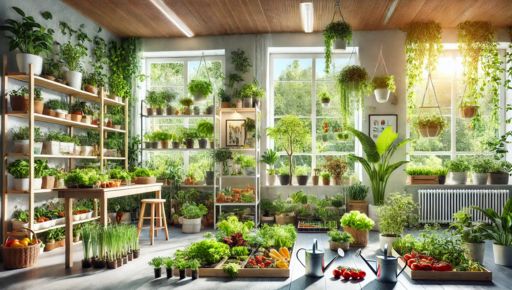Creating a garden of vegetables in your house is a rewarding and sustainable way to ensure a steady supply of fresh, homegrown produce. Whether you’re a seasoned gardener or a beginner, having a vegetable garden inside your home can offer numerous benefits, including healthier meals, cost savings, and the joy of nurturing plants. In this article, we will guide you through the steps to create your own garden of vegetables in house, including tips on selecting the right plants, setting up the garden space, and maintaining it for optimal growth.
Why Have a Garden of Vegetables in House?
A garden of vegetables in house provides a convenient and accessible way to grow your own food, especially if you have limited outdoor space or live in an urban environment. There are several reasons why you might want to consider starting an indoor vegetable garden:
- Fresh, Organic Produce: Growing vegetables at home ensures that you have fresh, organic produce without the use of harmful pesticides or chemicals.
- Save Money: By growing your own vegetables, you can reduce your grocery bills and rely less on store-bought produce.
- Sustainability: Indoor gardening is a sustainable way to produce food, and it helps reduce the carbon footprint associated with shipping and packaging.
- Year-Round Growing: With the right setup, you can grow vegetables all year round, regardless of the weather outside.
Choosing the Right Vegetables for Your Indoor Garden
Not all vegetables are suitable for indoor gardening, so it’s important to select varieties that thrive in limited space and lower light conditions. Here are some of the best vegetables to grow in a garden of vegetables in house:
- Lettuce and Leafy Greens: These vegetables are perfect for indoor gardens because they grow quickly and don’t require a lot of sunlight. Varieties like spinach, kale, arugula, and romaine lettuce do well in containers or window boxes.
- Herbs: Fresh herbs such as basil, cilantro, parsley, and mint are excellent choices for an indoor vegetable garden. They don’t take up much space and can be grown on windowsills or small shelves.
- Tomatoes: Dwarf or determinate tomato varieties are ideal for indoor gardens. These plants produce compact vines that require minimal space while still yielding delicious, ripe tomatoes.
- Radishes: Radishes are fast-growing and require little maintenance, making them a great addition to your indoor vegetable garden. They can be grown in small containers and harvested in just a few weeks.
- Peppers: Small pepper varieties, such as chili peppers or bell peppers, can thrive indoors when given plenty of light and warmth.
Setting Up Your Indoor Garden of Vegetables
Once you’ve chosen the right vegetables for your garden of vegetables in house, it’s time to set up your growing space. Here are some tips to create the perfect environment for your indoor garden:
- Choose the Right Containers: Make sure to select containers that are large enough to accommodate the roots of your vegetables and have drainage holes to prevent waterlogging. You can use pots, window boxes, or even repurposed containers like plastic bottles.
- Provide Sufficient Light: Most vegetables need at least 6-8 hours of sunlight per day to thrive. If you don’t have a sunny window, consider using grow lights to provide the necessary light for your plants.
- Maintain Proper Temperature: Vegetables generally prefer temperatures between 65°F and 75°F. Ensure that your indoor garden is placed in a warm location and protected from cold drafts.
- Use Quality Soil: Choose a high-quality potting mix that is well-draining and rich in nutrients. This will provide your plants with the foundation they need to grow strong and healthy.
- Watering: Regular watering is essential for indoor vegetable gardens, but be sure not to overwater. Most vegetables prefer moist soil but not waterlogged conditions. Check the soil regularly and water when the top inch feels dry.
Maintaining Your Garden of Vegetables in House
Taking care of your indoor garden requires regular attention and care. Here are some tips to help you maintain a healthy garden of vegetables in house:
- Fertilize Regularly: Indoor plants need a steady supply of nutrients. Use an organic fertilizer or compost every few weeks to keep the soil rich and healthy.
- Prune and Harvest: Regularly prune your plants to encourage healthy growth and remove any dead or damaged leaves. Harvest vegetables when they are ripe to encourage new growth.
- Pest Control: While indoor gardens are less prone to pests, it’s still important to check for any signs of infestations. Use natural pest control methods, such as neem oil or insecticidal soap, if necessary.
Conclusion
A garden of vegetables in house can bring numerous benefits to your home, from fresh food to a more sustainable lifestyle. By choosing the right vegetables, setting up your garden space properly, and maintaining it with care, you can enjoy a bountiful indoor vegetable garden all year long. Whether you have a small apartment or a spacious home, growing vegetables indoors is a great way to improve your quality of life while reducing your environmental impact. Happy gardening!
4o mini



